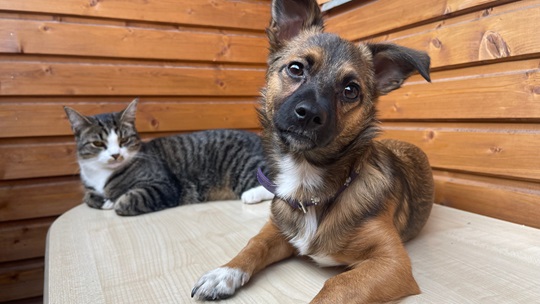Quantification of life expectancy in dogs and cats
 Human life expectancy has been tracked for almost 200 years, but robust analyses of life expectancy for pets are scarce. Data on life expectancy are useful for revealing the overall health status of a population and understanding the potential impacts of health conditions and medical interventions on lifespan.
Human life expectancy has been tracked for almost 200 years, but robust analyses of life expectancy for pets are scarce. Data on life expectancy are useful for revealing the overall health status of a population and understanding the potential impacts of health conditions and medical interventions on lifespan.
We at Banfield Pet Hospital collaborated with researchers at Royal Canin, a Mars Petcare brand focused on health through nutrition, to create life expectancy tables for dogs and cats in the United States using data from millions of pets visiting approximately 1,000 Banfield hospitals from 2013 to 20191.
Life expectancy at birth averaged 12.69 years for dogs and 11.18 years for cats. Body condition score (BCS), among other variables, significantly influenced life expectancy in both dogs and cats. Our analysis demonstrates the power of big data to improve veterinary care and support our purpose: a better world for pets.
What this means for veterinary teams
Accurate information on life expectancy for dogs and cats can help veterinary professionals educate, set expectations, and assess medical conditions, like obesity, and work effectively with clients to ensure that pets receive the best care possible.
Overall life expectancy
We used Sullivan’s method – a popular methodology used by the World Health Organization – to analyze life expectancy overall and by survey year, sex, breeding heritage, and adult body size (purebred dogs only: toy, small, medium, large, and giant). Overall life expectancy at birth was 12.69 years for dogs and 11.18 years for cats. Life expectancy increased in each survey year from 2013 to 2018 for both dogs and cats. Females had significantly longer life expectancy than did males: 12.76 years vs. 12.63 years for dogs, and 11.68 years vs. 10.72 years for cats. Life expectancy was slightly longer for mixed-breed dogs than for all dogs but slightly shorter for mixed-breed cats than for all cats. Among purebred dogs, life expectancy increased as adult body size decreased.
Influence of obesity on life expectancy
Obesity is the most common nutritional disorder in companion animals2 and is associated with reduced lifespan in dogs3 and cats4. To quantify the influence of obesity on life expectancy in pets, we generated life expectancy tables for subpopulations of dogs and cats defined by median BCS (using a 5-point scale) throughout their life. Obese dogs (BCS 5) had significantly shorter life expectancy (11.71 years) than did overweight dogs (BCS 4; 13.14 years) or dogs with ideal body condition (BCS 3; 13.18 years). Cats with BCS 4 had significantly longer life expectancy (13.67 years) than did cats with BCS 5 (12.56 years).
Conclusions
Our analysis of life expectancy for dogs and cats in the US – the first of its kind – was made possible by big data. Where available, large datasets can be used to analyze life expectancy in other countries, different veterinary care settings, and subpopulations of pets. Life expectancy analyses can help veterinary teams better assess care and treatment options and advise owners of their potential benefits. For example, recognizing the reduction in life expectancy associated with overweight and/or obesity might encourage veterinarians and pet owners to prioritize proactive body weight management. At the population level, life expectancy is a useful indicator of general pet health, which reflects the accessibility and quality of veterinary medicine.
We also hope this that type of analysis might be a springboard for additional studies, evaluating the impacts of particular medical conditions (e.g., diabetes mellitus) or specific treatment interventions (e.g., insulin administration) in an affected population. Working together, we can continue to utilize science and research to support our shared priority of advancing pet health.
1Montoya M, Morrison JA, Arrignon F, Spofford N, Charles H, Hours M-A, Biourge V. Life expectancy tables for dogs and cats derived from clinical data. Front Vet Sci. (21 February 2023) doi: 10.3389/fvets.2023.1082102
2German AJ. The growing problem of obesity in dogs and cats. J Nutr. (2006) 136:1940S–6S. doi: 10.1093/jn/136.7.1940S
3Salt C, Morris PJ, Wilson D, Lund EM, German AJ. Association between life span and body condition in neutered client-owned dogs. J Vet Intern Med. (2019) 33:89–99. doi: 10.1111/jvim.15367
4Teng KT, McGreevy PD, Toribio JL, Raubenheimer D, Kendall K, Dhand NK. Strong associations of nine-point body condition scoring with survival and lifespan in cats. J Feline Med Surg. (2018) 20:1110–8. doi: 10.1177/1098612X17752198
